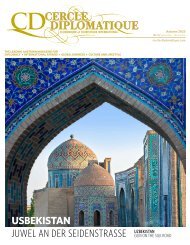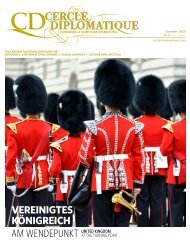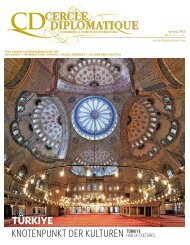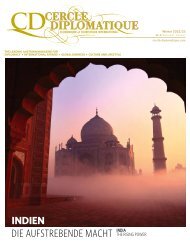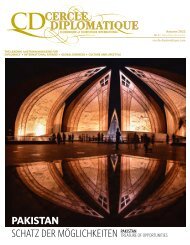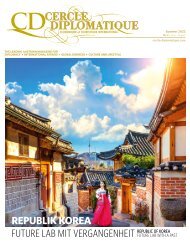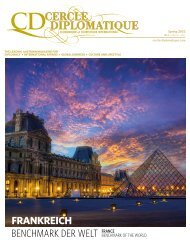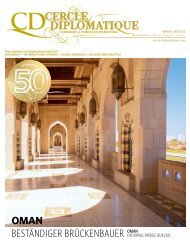CERCLE DIPLOMATIQUE - issue 02/2020
CD is an independent and impartial magazine and is the medium of communication between foreign representatives of international and UN-organisations based in Vienna and the Austrian political classes, business, culture and tourism. CD features up-to-date information about and for the diplomatic corps, international organisations, society, politics, business, tourism, fashion and culture. Furthermore CD introduces the new ambassadors in Austria and informs about designations, awards and top-events. Interviews with leading personalities, country reports from all over the world and the presentation of Austria as a host country complement the wide range oft he magazine.
CD is an independent and impartial magazine and is the medium of communication between foreign representatives of international and UN-organisations based in Vienna and the Austrian political classes, business, culture and tourism. CD features up-to-date information about and for the diplomatic corps, international organisations, society, politics, business, tourism, fashion and culture. Furthermore CD introduces the new ambassadors in Austria and informs about designations, awards and top-events. Interviews with leading personalities, country reports from all over the world and the presentation of Austria as a host country complement the wide range oft he magazine.
You also want an ePaper? Increase the reach of your titles
YUMPU automatically turns print PDFs into web optimized ePapers that Google loves.
LE MONDE ESSAY
Celebrating 75 years of Austria II and
65 years since the Austrian State Treaty
HEINZ FISCHER was born
in Graz in 1938 and studied
law at the University of
Vienna from which he
graduated in 1961. The
former Austrian politician
(Social Democratic Party of
Austria) was Federal
President of the Republic of
Austria from 2004 to 2016.
Prior to this, he was
Minister of Science and
Research and a member of
the National Council, as well
as President and Second
President of the Austrian
National Council.
In January 2018, he and
former UN Secretary-
General Ban Ki-moon
founded the “Ban Ki-moon
Centre for Global Citizens”
in Vienna.
bankimooncentre.org
Austria’s former Federal President on past and current challenges.
Alittle more than 100 years ago, on 12 November
1918, the Democratic Republic of Austria
(then known as German-Austria) was
founded as a German-speaking successor state to the
multinational Austro-Hungarian Empire.
The existence of this state, which shared the same
capital city as the old Austro-Hungarian Empire – namely
Vienna – and whose territory and population
were less than a sixth of the old empire, was extremely
precarious.
Yet, the new alpine republic on the Danube yielded
considerable achievements in terms of the advancement
of modern social policy, the creation of a new
democratic constitution, agreed upon on 1 October
1920 (almost exactly 100 years ago), as well as the sciences
and the arts.
But a persistent economic crisis, an unemployment
wave, political tensions and external pressures
(from Hitler in particular) led to the self-elimination
of the Austrian parliament, the Austrian Civil War in
1934 and finally to the annexation of Austria to Hitler’s
Germany following a threatening military ultimatum
from Berlin. This is how Austria, now part of the
“Greater German Reich”, was drawn into the Second
World War.
After Austria had been described by Secretary of
State Hull (USA), Foreign Secretary Eden (UK) and
Minister of Foreign Affairs Molotov (USSR) as the
first free nation “that fell victim to Hitler’s policy of
aggression” in the Moscow Declarations of 1 November
1943, Austria appropriated this “victim theory”. It
would take until the 1980s for the realisation to set in
that though the Austrian Republic had indeed been a
victim of Hitler’s military aggressions through the invasion
of German troops into Austria and had lost its
independence, and though there had indeed been
many victims of the Nazi dictatorship in Austria, there
had also been many perpetrators and accomplices that
served the Hitler regime.
The beginning of April in 1945 saw the week-long
Vienna Offensive, but once the last Wehrmacht soldiers
had been expelled from Vienna by the Red Army
by 13 April, the efforts to reinstate an independent and
democratic Austria commenced immediately.
Representatives from the Social Democrats, the
former Social Christians (who re-established themselves
as the Austrian People’s Party in April 1945) and
PHOTOS: SIMONIS, BKMC EUGENIE BERGER, ECOWIN VERLAG
the Communists came together under Dr Karl Renner,
former Chancellor from 1918/1919, and unitedly
drafted an independence declaration. Furthermore,
they agreed on the formation of a broad coalition
government with all three parties and formulated a
joint government programme.
The now-famous article 1 of the independence declaration
of 27 April 1945 states: “The democratic Republic
of Austria is reinstated and to be instituted in
the spirit of the Constitution of 1920”. Article 2 continues
with the assessment: “The annexation forced
upon the Austrian people in 1938 is nil and void”.
Since this provisional government in Vienna was
recognised by all other Austrian provinces and
perhaps most importantly by the four occupying
forces, the whole country (in contrast with Germany)
could participate in the country’s political, economic
and social reconstruction under one government.
On 25 November 1945, parliamentary elections
were held all over Austria, which gave the Austrian
People’s Party 85 mandates, the Social Democrats 76
and the Communist Party (which had hoped for 20 %
of the votes) just 4 (5 % of votes).
The cooperation between the different parties was
initially continued under the helm of Chancellor Leopold
Figl, though the Communists exited the government
in 1947. From then, the ruling government was
a coalition between the Austrian People’s Party and
the Social Democrats. Illustrating that fortune does
indeed favour the bold, Stalin’s death in March of 1953
allowed for the conclusion of the long-awaited Austrian
State Treaty, a situation which was cleverly and prudently
taken advantage of by the Austrian government.
The Austrian State Treaty, which did not relate to
Austria’s neutrality in a legal but in a political manner
and yielded for Austria the withdrawal of the occupying
forces as well as total freedom and independence,
was signed on 15 May 1955, 65 years ago – a day I still
remember vividly.
By 25 October 1955, the last foreign occupying soldier
had to depart our country, on 26 October the
constitutional law on Austria’s continued neutrality
was passed and just a few weeks later, on 14 December
1955, Austria joined the United Nations.
This made Austria a full and equal member of the
community of nations.
Events of significant relevance for us were the subsequent
Hungarian Revolution occurring next door in
1956, which resulted in 150,000 refugees as well as the
Prague Spring of 1968.
The years from 1970 to 1983 were a time of great
reforms and important foreign policy engagements
for Austria, also known as the “Kreisky Era” today. The
fall of the Iron Curtain between Western and Eastern
Europe in 1989 was followed by Austria’s accession to
the European Union in 1995 and the 2004 EU enlargement.
Today, 16 years after the enlargement, we can
also look back on the financial crisis of 2008, unfortunately
also on the rise of certain national and nationalistic
trends in Europe (and not only Europe) and,
in most recent times, the coronavirus pandemic,
which is going to have lasting effects on the global economy.
Despite this, we can say that the 75 years following
the end of the Second World War have seen positive
and mainly stable developments for Austria, Europe
and many other countries. Accordingly, we can clearly
see the benefits of a democratic and constitutional society,
and the responsibility to learn from history and
to remain vigilant.
BOOK TIP
Open-minded thinker and pioneer,
passionate social democrat and former
Federal President of the Republic of
Austria: Heinz Fischer has seen and
shaped the nation’s history in a multitude
of ways. He used the occasion of his 80th
birthday in 2018 to look back on the
many paths taken in his life.
The result is a long arc that spans from
historical events all the way to
contemporary political issues.
Spaziergang durch die Jahrzehnte
Ecowin, ISBN: 978-3-7110-0176-4
True friendship: Heinz
Fischer (left) with the
former UN Secretary-
General Ban Ki-moon at
Forum Alpbach in August
2019.
50 Cercle Diplomatique 2/2020
Cercle Diplomatique 2/2020
51





